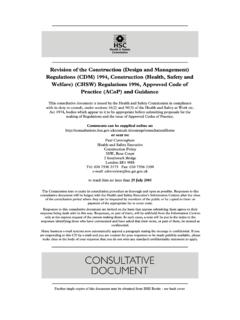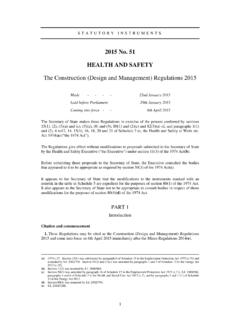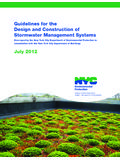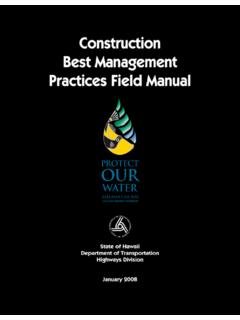Transcription of London 2012: The Construction (Design and Management ...
1 Health and Safety Executive London 2012: The Construction ( design and Management ) regulations 2007 Dutyholder roles and impact Prepared by Frontline Consultants for the Health and Safety Executive and the Institution of Civil Engineers 2012 RR941 Research Report Health and Safety Executive London 2012: The Construction ( design and Management ) regulations 2007 Dutyholder roles and impact Frontline Consultants Central Court 25 Southampton Buildings London WC2A 1AL This project researched the extent to which CDM helped or hindered the Construction of London 2012 by reviewing how CDM duties were put into practice. The research was based on interviews with ODA Sponsors, Designers, CDM Coordinators, Tier 1 Contractors and CLM Project Managers on nine projects.
2 In addition, a structured workshop was held with a range of dutyholders from a range of projects. We found that CDM 2007 had been extended and implemented successfully. In particular: n The Client (ODA/CLM) had a significant impact on health and safety. n Early and ongoing planning, coordination and Contractor involvement were crucial. n Principal Contractors shared ideas and lessons learned. n Worker engagement helped to motivate the workforce and get key messages across. n When compared with the wider Construction industry, London 2012 scored significantly higher in 27 of the 39 Influence Network factors. Lessons applicable elsewhere in Construction include: n Clients taking the leadership role. n Engaging workers. n Initiatives to improve health and safety culture.
3 N Allowing and encouraging workers to report unsafe activities. n Integrating teams of Designers, Contractors and CDM Coordinators early and often. n Focussing on getting the right competences in individuals and organisations. n Forums for sharing knowledge between organisations and sharing office facilities were more appropriate for other large programmes. This report, and the work it describes, was commissioned by the Olympic Delivery Authority and funded by the Health and Safety Executive and the Institution of Civil Engineers. Its contents, including any opinions and/ or conclusions expressed, are those of the authors alone and do not necessarily represent the policy of those commissioning or funding it. HSE Books Crown copyright 2012 First published 2012 You may reuse this information (not including logos) free of charge in any format or medium, under the terms of the Open Government Licence.
4 To view the licence visit , write to the Information Policy Team, The National Archives, Kew, London TW9 4DU, or email Some images and illustrations may not be owned by the Crown so cannot be reproduced without permission of the copyright owner. Enquiries should be sent to ACKNOWLEDGEMENTS The authors would like to express their enormous gratitude to the large number of people who provided their valuable time and input to the interviews and workshop. The authors are also grateful for the valuable input provided by the project working group over the whole life of this project from planning to reporting. This working group comprised representatives of HSE, ICE and ODA/CLM. This research is part of a suite of research projects and independent evaluations undertaken on health and safety on the London 2012 Construction programme comprising: n Leadership and worker involvement on the Olympic Park.
5 N Occupational health provision on the Olympic Park and Athletes Village. n London 2012: The Construction ( design and Management ) regulations 2007 duty holder roles and impact. n Safety culture on the Olympic Park. n Pre-conditioning for success. n Communication and action for a safer London 2012 Olympic and Paralympic Games. n Supply chain Management for health and safety n Food safety and sustainability (Case study). Research summaries are accessible on the London 2012 Learning Legacy website ( com/themes/health-and- ) and should be read in conjunction with the summary for the project below which provides an overview of health and safety on the London 2012 Construction programme: n Delivering health and safety on the development of the London 2012 Olympic Park and Athletes Village.
6 Full research reports for all projects are/will be published on the HSE or IOSH websites. ii CONTENTS GLOSSARY AND LIST OF ACRONYMS vii KEY MESSAGES xi EXECUTIVE SUMMARY xii 1. INTRODUCTION 1 Aims and objectives of this report 1 The Learning Legacy Programme of research on health and safety 2 Construction of London 2012 3 Research approach 4 Structure of this report 5 2. INTERVIEWS: THE IMPLEMENTATION OF CDM 2007 IN London 2012 7 Implementation of CDM 2007 7 Although the approach was driven by regulatory requirements, it would have probably been undertaken in a similar way as part of good Construction practice 8 The complexity and scale of the programme along with the need for large numbers of contractors to work in a relatively small area had a definable impact on the implementation of CDM 2007 9 Whilst health and safety has been a priority from day one, changes in culture have been noticed with time 10 Both the outcome and process were positive, and they can be replicated elsewhere 10 There were few negative aspects.
7 But the main ones centred around the amount of paperwork required by the programme 11 3. INTERVIEWS: BENEFITS OF CDM 2007 13 There are instances where health and safety benefits could be linked directly to CDM 2007 13 iii Business benefits can be linked directly to good health and safety performance and CDM 2007 14 Good Construction practices were being brought into London 2012, being developed on London 2012 and were already being applied elsewhere 15 CDM 2007 roles and structures match the natural mechanisms for undertaking contractors business 16 CDM 2007 needs to be embedded in projects from the outset and associated with quality Management to ensure that it is aligned with business practices 16 Provided it is implemented correctly, CDM 2007 should not be a disproportionate burden or an impediment to efficient Management of Construction 16 4.
8 INTERVIEWS: CDM 2007 IN THE CONTEXT OF HEALTH AND SAFETY PRACTICE 19 The major factors that have led to the Construction programme being successful in terms of health and safety can be categorised as CDM 2007-related activities and Contractor-led initiatives 19 Besides CDM 2007, client leadership and contractor-led initiatives had a major influence on health and safety on London 2012 20 CDM 2007 had a significant impact on designing for Construction and legacy use, whilst site initiatives were more significant for controlling health and safety on site 21 There were few health and safety shortcomings and, where they did occur, lessons were learnt and shared 22 Health and safety standards were at a very high level on London 2012, but that did not stop contractors wanting to improve things still further 22 5.
9 INTERVIEWS: EFFECTIVENESS OF CDM 2007 25 CDM 2007 as implemented on London 2012 was found by the respondents to be clear and easy to understand 25 CDM 2007 is appropriate for use with the forms of contract currently used on London 2012 and shares a similar philosophy with the NEC 3 form of contract 26 iv Paperwork had reduced in some areas, but the programme itself required significant amounts of paperwork 26 There has been significant coordination and co-operation, but it is difficult to allocate this to the influence of CDM 2007 27 On balance.
10 CDM 2007 simplified the assessment of competence 28 6. INTERVIEWS: TRANSFERRING THE LESSONS LEARNED BEYOND London 2012 29 There are a number of factors that are unique to London 2012 29 A range of lessons is applicable elsewhere in the Construction industry, and many relate to the way of working 29 7. INFLUENCE NETWORK: KEY FACTORS RELATING TO HEALTH AND SAFETY AT London 2012 31 Introduction 31 The Influence Network 31 Workshop process 33 Factor ratings 34 Factor discussions 35 Weightings 41 Workshop conclusions 44 8. COMPARING London 2012 WITH THE WIDER Construction INDUSTRY 45 Comparison of London 2012 with workshops held as part of the evaluation of CDM 2007 45 Identifying how London 2012 addresses the issues raised during the evaluation of CDM 2007 53 9.

















